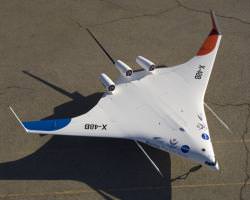The flying wing is an old design, but NASA aerospace engineers think it might be just what the airline industry needs. As part of their research into this concept, the agency recently tested out the X-48B flying wing prototype. If this design matches the developers’ ambitions, it could usher in a new class of aircraft which would be quieter and use less fuel.
The remotely controlled 6.4 metre (21-foot) wingspan aircraft took off from NASA’s Dryden Flight Research Center on July 20th, 2007. It climbed to an altitude of 2,286 metres (7,500 feet), and then landed again 31 minutes later.
Designed and built by Boeing’s Phantom Works, the X-48B was created to help engineers explore the flight dynamics of this aircraft shape. Instead of the traditional fuselage and wings, the X-48B looks just like flying wing, which blends smoothly into a wide, flat, tailless fuselage. The blend between the wing and fuselage gives the aircraft additional lift and less drag compared to a circular fuselage.
Powering the vehicle are three turbojet engines. These are 8.5% scale, which allow the aircraft to fly up to 3,000 metres (10,000 feet) altitude, and reach speeds of 220 kph (138 mph). The engines are mounted high up on the fuselage in the back, and making it both quieter inside, and on the ground.
NASA is planning 25 more test flights with the X-48B to gather data in low-speed maneuvers. Then they might use the prototype to see if it’s truly quiet and how it handles at transonic speeds.
Original Source: NASA News Release

